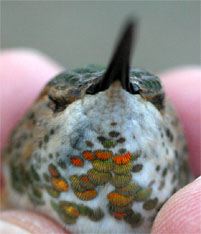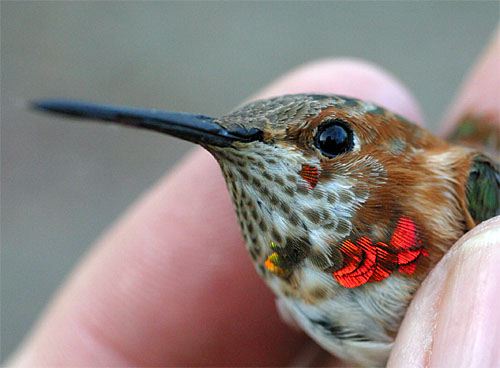|
|
|||
|
RUFOUS HUMMINGBIRD |
|
Back on 24 March 2003, we journeyed from Hilton Pond Center to Seneca SC, in Oconee County west of Clemson. There we visited the home of Nellie and Clayton Land, who had been hosting two--perhaps three--winter hummingbirds. To make a long story short, we were unable to capture any birds at the Land residence that day, but returned a week later and managed to net an after-hatch-year female Rufous Hummingbird that we banded with #Y14807 (below). This bird had a small, healed-over bump at the base of her bill, possibly the result of an old injury or an infection, and she soon departed--likely to breed somewhere in western North America. After this flurry of activity last March, we weren't surprised to hear from Nellie Land when--on about 7 December 2003--an apparent Rufous Hummingbird began visiting her feeder, or that there might actually be two birds--a green-backed one that was likely a female and a brownish hummer that was probably a young male. Taking advantage of our annual Christmas-related trip to visit family in nearby Greenville, we arranged with the Lands to stop by early on the morning of 26 December to trap and verify the birds at their feeders. This time, we had much better results.
Rufous Hummingbird #Y14807 in March 2003 (above left) All text & photos © Hilton Pond Center After a 45-minute pre-dawn drive, we arrived in Seneca at 6:45 a.m., set up our portable hummingbird trap, placed the Lands' feeder inside it, and hung the mechanism from a hook outside the living room window. At 7 a.m. we all went inside to watch the trap while we got caught up on the latest news about local hummingbirds. Fifteen minutes later the first hummer appeared and entered the trap with little hesitation; just as quickly, we hit the button on our remote trapdoor release and went to remove the bird from the trap. First off, we checked the bird's right leg and, sure enough, it bore a tiny aluminum band inscribed with #Y14807--the same Rufous Hummingbird we had banded at the Lands' on the last day of March during the current calendar year. We suspect this bird left Seneca in early April and made her way across the Great Plains to ancestral nesting grounds in the northwestern U.S., western Canada, or even as far north as southern Alaska. There are no records of nesting Rufous Hummingbirds here in the East, but if the numbers of vagrants continue to grow and these birds begin to stay later in spring, we wouldn't be surprised to learn someday that Rufous hummers have extended their breeding range into what is now the exclusive nesting domain of the Ruby-throated Hummingbird. This returning female Rufous looked a bit different than she did last spring (see photos above), having molted all her plumage at least once, and she had a few more metallic orange-red throat feathers. Of special interest was the old wound on her upper bill; it apparently had healed over completely and we might have missed the tiny bump that remained had we not been looking specifically for it. While we were re-measuring and examining #Y14807, Clayton Land was keeping a close eye on the hummingbird trap and hoping a second bird would appear. Sure enough, at 7:30 a.m. a hummer zipped into view and checked out the trap with the feeder within. The bird seemed to have trouble finding the door to the trap and made several visits before--at 7:35 a.m.--it finally flew in and we hit the release button again. We quickly finished taking photos of #Y14807 and went to the trap to remove the newcomer.
Even from a distance there was little doubt that this second bird was a young male Rufous Hummingbird, Selasphorus rufus; the presence of several rusty feathers on its dorsal side (below) meant it couldn't be the closely related but green-backed Allen's Hummingbird, S. sasin. This bird also had a good deal of rusty color at the base of its tail, and its throat already bore 20 or more metallic organge-red feathers. In the coming months this immature hummer should complete its iridescent gorget and become completely rusty on head and back.
Unfortunately, the young male was quite fidgety, so it slipped out of our grip after banding but before we could complete our usual series of photos that illustrate all aspects of the bird's plumage. The ones we did get (above and below), do depict the advanced molt of this first-year male Rufous. Vital Statistics for
All text & photos © Hilton Pond Center
If you're interested in sharing your hummingbird observations and learning from other enthusiasts, you may wish to subscribe to Hummingbird Hobnob, our Yahoo!-based discussion group. Also be sure to visit our award-winning Web site for Operation RubyThroat: The Hummingbird Project; on it you'll find almost anything you want to know about hummingbirds, including more information about Hummingbird Banding.
For much more information about hummingbirds, visit: |
|
Make direct donations on-line through
Network for Good: |
|
|
LIKE TO SHOP ON-LINE?
Donate a portion of your purchase price from 500+ top on-line stores via iGive: |
|
|
Use your PayPal account
to make direct donations: |
|

 . . .
. . . 




 Students at GLOBE-certified schools may submit winter hummingbird observations as part of Operation RubyThroat and GLOBE. Students can also correlate hummingbird observations with data on abiotic factors, including atmosphere, climate, hydrology, soils, land cover, and phenology. See the
Students at GLOBE-certified schools may submit winter hummingbird observations as part of Operation RubyThroat and GLOBE. Students can also correlate hummingbird observations with data on abiotic factors, including atmosphere, climate, hydrology, soils, land cover, and phenology. See the 



